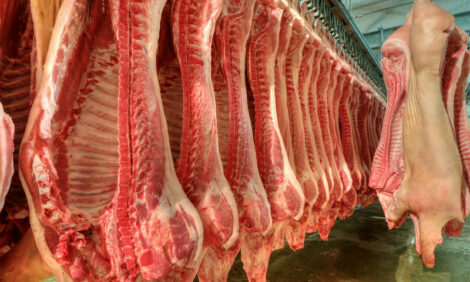



Market Preview: Pressures Ease Just a Little
US - Weekly US Market Preview provided by Steve R. Meyer, Ph.D., Paragon Economics, Inc.There was a lot to be positive about in the pork industry the last week of October. I realize it is difficult to be optimistic when you are still losing $25 to $30/head. I also realize that positive news at this point could be as dangerous as it is welcome. But facts are facts, and we must recognize them.
Pork cutout values continued a rally that has been rather low on magnitude, but is now three weeks old (see Figure 1). The $1.73/cwt. increase last week was driven by increases in hams, bellies and trimmings, so it wasn’t just a one-trick pony. The increase puts this rally at over $4/cwt. during October – a month usually not known for product price rallies.

Slaughter levels have been very close to the levels expected from the September USDA Hogs and Pigs report and average slaughter weights actually got back to a level equal to year-earlier levels for the first time since the week of 28 March. Those two factors have led to much more manageable supplies.
In addition to higher cash pork prices, Chicago Mercantile Exchange (CME) futures markets are offering opportunities to lock in lower costs and higher revenues than just a few weeks ago. Lean Hog futures continued their rally this week with most contracts reaching their highest levels since late July.
And the news was good on the cost side of the ledger, too. Lower corn and soybean meal futures leave my cost estimates for November 2009 through December 2010 at an average of $66.28/cwt., carcass, $1.20 lower than two weeks ago.
Put those two together and the futures markets now suggest profits in six months of 2010 (see Figure 2). Average losses for November ’09 through December 2010 are back down to $2.70/cwt., or roughly $5/head – and that is if your production parameters are equal to those assumed by the Iowa State University (ISU) cost and returns estimates. Many producers have higher productivity and lower cost relationships than are suggested by these “average” numbers from ISU. Friday’s closing futures prices will actually mean profits for those producers.

Pork Export Potential Improving
And then there are exports, or at least the potential for exports. China’s announcement that it would resume imports of US pork was welcome news. It came three weeks after the US Congress reversed its de facto ban on USDA’s doing a risk assessment on Chinese cooked chicken imports. While a market of 1.3 billion people is always lucrative, we should not begin gearing up pork output just yet. China has rebuilt its breeding herd during the past two years and a spotlight as bright as that of the Olympic Games will not be shining on it anytime soon. In addition, China’s currency is pegged to the dollar, so the weakening US dollar will not have as much effect on exports to China as it does on exports to other countries. Good news? Yes. Does it mean a boon for exports in the short run? Probably not.
The other “potential export” development is the apparently worsening African Swine Fever outbreak in Russia. I’m not suggesting in the least that we should take joy in this situation -- just as we should not have (and I don’t think anyone did) take any joy in the pig death losses in China in 2006 and 2007. But it is a fact and the US can play a major role in getting meat protein to Russia’s people if this outbreak gets worse.
Futures Prices Can be “Your” Prices
So, our task is to decide which of these “potential” positives will come true. One certainty is that pork producers can make the “potential” prices of futures markets their actual prices simply by buying the ingredient futures (or call options on them) or selling the hogs futures (or put options on them). There are costs to doing that, of course, but those futures prices are more than pipe dreams. They can be your prices if you deem them acceptable and take action.
The futures-implied hog price for the week of 2 July 2010 is $72.39. The national weighted-average net negotiated price for that same week in 2009 was $58.08, which means the futures market is offering a year-on-year price increase of 24.6 per cent. My calculations using the September Hogs and Pigs report and expected changes in imports from Canada say that slaughter in early July will be 2.5 per cent lower than this past year. Those changes imply a price flexibility of nearly 10:1, where I usually use 3:1 to compute expected price changes from forecasted slaughter changes.
The bottom line is that current Lean Hog futures markets are apparently forecasting much higher demand in 2010. Stronger demand is indeed likely given the challenges we have had in 2009, but the magnitude implied by the futures markets appears to be very large.










